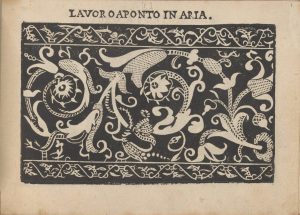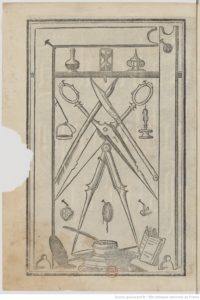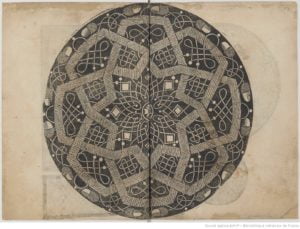Pattern Books for Embroidery and Lace-making
 Pattern books for embroidery were introduced Europe in the late-1520s, with those for making different types of lace following in the decades after. These books were intended for use by both professionals and amateurs; to start they were often dedicated to noblewomen, but overtime the dedications shifted to women that oversaw the production of domestic needlework. Some of the early books, such as Giovanni Antonio Tagliente’s Opera nuova (Giovan Antonio et fratelli da Sabbio: Venice, 1527) offered fairly detailed instructions on how this kind of work should be carried out as well as images of the different tools required; however, most of the books assume a fairly high level of knowledge and skill of their audience, with no formal instruction and simply patterns (though these were not usually simple at all!).
Pattern books for embroidery were introduced Europe in the late-1520s, with those for making different types of lace following in the decades after. These books were intended for use by both professionals and amateurs; to start they were often dedicated to noblewomen, but overtime the dedications shifted to women that oversaw the production of domestic needlework. Some of the early books, such as Giovanni Antonio Tagliente’s Opera nuova (Giovan Antonio et fratelli da Sabbio: Venice, 1527) offered fairly detailed instructions on how this kind of work should be carried out as well as images of the different tools required; however, most of the books assume a fairly high level of knowledge and skill of their audience, with no formal instruction and simply patterns (though these were not usually simple at all!).
These books are valuable for our project in that they offer a way for people that perhaps could not afford to hire a professional embroiderer to embellish their clothing and accessories at home. The patterns in the books were also often described as exotic and new, so might have given artisans and their families a means of participating in trends through the decoration of small parts of their clothing. Pattern books also offer a glimpse into the production of textiles by women working from home. Although learning to embroider or make lace could be a key part of the education of girls and young women from elite families, women from all social classes were expected to be able to work with a needle and thread, not just as a ‘noble pastime’ but as a means of earning an income. The books give us insight not only into patterns and styles that people wanted to incorporate into their clothing and other textiles, but working practices and techniques no longer in use today.
Suggested reading:
Arthur Lotz,Bibliographie der Modelbücher (Leipzig: Karl W. Hiersemann, 1933).
Ann Rosalind Jones, “Labor and Lace: The Crafts of Giacomo Franco’s Habiti Delle Donne Venetiane,” I Tatti Studies17, no. 2 (Fall 2014): 399–425.
Femke Speelberg, “Fashion & Virtue: Textile Patterns and the Print Revolution, 1520–1620,” The Metropolitan Museum of Art Bulletin73, no. 2 (2015): 4–48.
Image 1: Isabetta Parasole, Pretiosa gemma delle virtuose donne(Lucchino Gargano: Venezia, 1600), p. 3r.Image courtesy of the Metropolitan Museum of Art.
Image 2 & 3: Giovanni Antonio Tagliente, Opera nuova (Giovan Antonio et fratelli da Sabbio: Venice, 1527). Images courtesy of Bibliothèque nationale de France, département Estampes et photographie.



